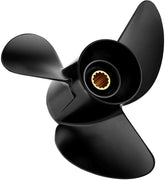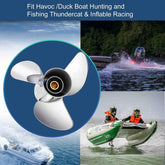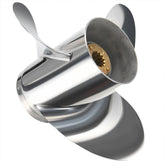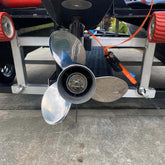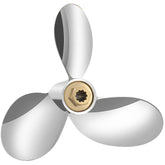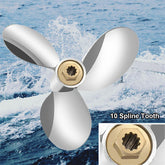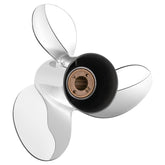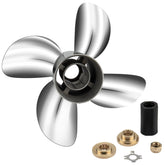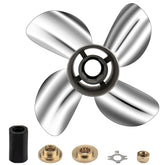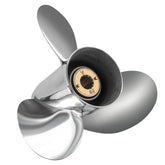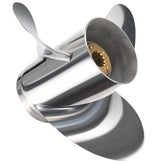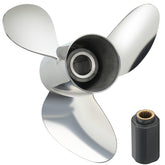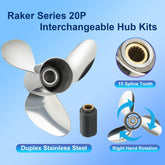Boat Propeller Buying Checklist — What to Confirm Before Ordering a Propeller for Your Outboard
If you’re about to order a propeller for your outboard — whether it’s a propeller for MERCURY, a Yamaha boat propeller fit, or a compatible prop for Honda, Suzuki or Volvo engines — this checklist makes the purchase fast, correct, and repeatable. Use it to confirm mechanical fit, match performance to how you actually use the boat, and avoid the common causes of returns and downtime.
Below you’ll find the exact questions to answer (and why), real-world examples drawn from VIF / POLASTORM product rows in your catalog, a simple field-test math routine you can run on the water, and a final pre-order checklist you can paste into procurement workflows.
Mechanical compatibility — start here and don’t skip it
Confirm engine make, model, year and HP group
Begin with the engine plate or service manual. Propeller fit is first and foremost determined by the lower unit and gearcase. Manufacturer recommendations sometimes change with model year even for the same HP. In your product table the first filter should be the Engine HP & the year grouping — it narrows the candidate list quickly.
Match spline count and shaft diameter
If the spline count or shaft diameter doesn’t match, the prop won’t seat correctly and will damage the lower unit. Your spreadsheet contains OEM part cross-references and hub/spline fields for fast verification. Always match those values before you look at pitch or blade count.
Confirm hub type and rotation (RH / LH)
Hub design (elastomer insert vs. solid hub, Flo-Torq style) determines how a prop responds to shock loads and whether you can fit a readily available spare insert. Rotation matters: single engines typically use right-hand (RH) props; twins often require one LH unit. Check the Rotation and Hub/Spline columns in your product sheet.
Physical fit — clearance, diameter and skeg considerations
Verify diameter clearance and skeg fit
Diameter increases thrust but needs skeg clearance. Too large a diameter can cause cavitation or increase the risk of ground strikes. Cross-check the Diameter column against your lower unit geometry or field-measured clearance under the skeg.
Confirm prop shaft hardware
Make sure the prop nut, washer and cotter pin spec match what the lower unit requires. Small hardware differences cause lost props. Keep replacement prop nuts and cotter pins in spares for your most common engine families.
Performance fit — pitch, blade count and material tradeoffs
Understand pitch and how it affects the engine
Pitch is the single most important performance parameter. It is the theoretical distance (in inches) the prop moves forward during one revolution.
Practical formula:
Theoretical Speed (mph) = (RPM × Pitch in inches) ÷ 1056
Then measure speed and compute slip:
Slip = (Theoretical Speed − Measured Speed) ÷ Theoretical Speed
If your WOT RPM is above the engine’s recommended band → pitch too low (pick higher pitch). If WOT RPM is below the band → pitch too high (pick lower pitch).
Blade count — what you gain and what you give away
-
3-blade: Lower wetted area, better top speed and cruise efficiency. Ideal for runabouts and speed-focused hulls.
-
4-blade: Improved hole-shot, tighter low-speed handling, superior grip for heavy loads and towing (pontoon or tritoon owners love 4-blade).
-
5-blade+: Niche cases where extra blade area supports vibration damping or specialized thrust behavior.
Material — aluminum vs stainless steel
-
Aluminum: Cost-effective, easier to make serviceable after a ding, ideal for rental or casual use.
-
Stainless steel: Stiffer, holds shape under high RPM and heavy load, gives better power transfer and often small speed gains; preferred for performance and commercial applications.
Real VIF / POLASTORM examples (use these as starting points)
Below are representative rows from your product table — real parts you can reference on a job-sheet or in a parts catalog. These are starting candidates; field-test before you commit to a final pitch.
-
Portable outboards (4–6 HP)
Example: POLASTORM 9057-3078-06 — 3-blade; ~7.8" diameter × 6" pitch; RH; aluminum. Great for tenders and lightweight skiffs where maneuverability and low cost matter. -
Small planing outboards (8–9.9 HP)
Example: POLASTORM 9057-3085-06 — 3-blade; ~8.5" diameter × 6.5" pitch; RH. Balanced for bite and acceleration on light planing hulls. -
Recreational family boats (25–30 HP, 3" gearcase)
Example: POLASTORM 2857-3099-09 — 3-blade; 9.9" diameter × 9" pitch; RH. A solid baseline for 25–30 HP Mercury-style engines. Expect to test ±1" pitch for load differences. -
Stainless alternative for durability (6–15 HP group)
Example: POLASTORM 1219-3093-09 — 3-blade stainless for frequent saltwater use and better shape retention after impacts. -
4-blade candidate for pontoons and towing
Example: POLASTORM 9857-4087-05 — 4-blade; ~8.7" diameter × 5" pitch; RH. Better hole-shot and low-speed control for heavy, loaded pontoons.
Those SKU examples are pulled from your MERCURY tables — they map to the typical HP bands and hub types you’ve cataloged. Use them as the first physical parts to order for a field test.
A repeatable field-test routine to validate a candidate prop
Follow this on-water protocol to stop guessing and start choosing quantitatively.
Pre-test setup
Load the boat as you normally do. Use the same fuel, typical passengers and gear. Check that your GPS and tachometer are functioning.
Test steps
-
Run to WOT in calm water; record WOT RPM and GPS speed.
-
Run at normal cruise speed; record cruise RPM and speed.
-
Calculate theoretical speed using the formula above and compute slip.
-
Compare WOT RPM to the engine’s recommended WOT band for that model/year.
-
If WOT RPM is outside recommended range, change pitch in 1" increments and re-test.
Log results in a spreadsheet: engine, part SKU, pitch, diameter, WOT RPM, GPS speed, slip — repeatability is the key.
Safety, maintenance and ownership checks you must include before ordering
Inspect the shaft and seals before installing a new prop
Fishing line wraps and keel strikes often score shafts. Clean and inspect; a grooved shaft damages seals quickly and will leak.
Propeller guards — protection vs performance
Prop guards and baskets reduce entanglement and increase safety, but add drag. For rental fleets, shallow-water operators, or debris-prone lakes, guards often lower risk and reduce repair costs despite a small speed penalty.
Spares to ship with orders
Always ship spare hub inserts (if hub is modular), one spare aluminum prop for quick swap, spare prop nut and cotter pins. These inexpensive items drastically cut downtime.
Final pre-order checklist — confirm these 12 items before checkout
-
Engine make, model, year, and HP band confirmed.
-
Lower-unit gearcase size and spline count verified.
-
Hub type and required hub kit confirmed.
-
Rotation: RH or LH verified.
-
Shaft diameter and prop nut spec identified.
-
Diameter clearance under the skeg checked.
-
Candidate POLASTORM/OEM part number selected from the table.
-
Material chosen (aluminum / stainless) based on use-case.
-
Blade count and initial pitch chosen (document rationale).
-
Intended mission logged (cruise, towing, rental, performance).
-
Field-test plan (who, where, how to log WOT RPM and GPS).
-
Spare parts and repair kit added to the order (hub insert, prop nut, cotter pin, spare aluminum prop).
If any of the above is unknown, pause the order and get the specification confirmed. A wrong hub or spline is the single fastest way to a returned prop and a frustrated customer.
Quick answers to common buyer questions
Can I use the same prop in saltwater and freshwater?
Yes — fit and pitch do not change between water types. Choose stainless for frequent saltwater use for better longevity. Aluminum is fine but needs closer inspection after hits.
My engine is over-revving after a prop change. What next?
That indicates the pitch is too low. Increase pitch in 1" steps and retest until WOT RPM sits in the recommended band.
How many blades should I pick?
Pick 3 blades for top speed and efficient cruising; pick 4 blades for better hole-shot, towing and heavier loads (pontoons, tritoons, boats with lots of gear).
What is a spun hub?
A spun hub is an elastomer insert failure where the prop slips on the hub under load. Symptoms include sudden loss of top-end and increased slip. Keep spare inserts and train techs to diagnose.
Glossary
Pitch — distance in inches the prop moves forward per revolution in an ideal condition.
Diameter — tip-to-tip distance describing the prop’s disc size.
Slip — the percent loss between theoretical and actual speed.
Hub — center of prop connecting to the shaft; may contain elastomer inserts for shock protection.


